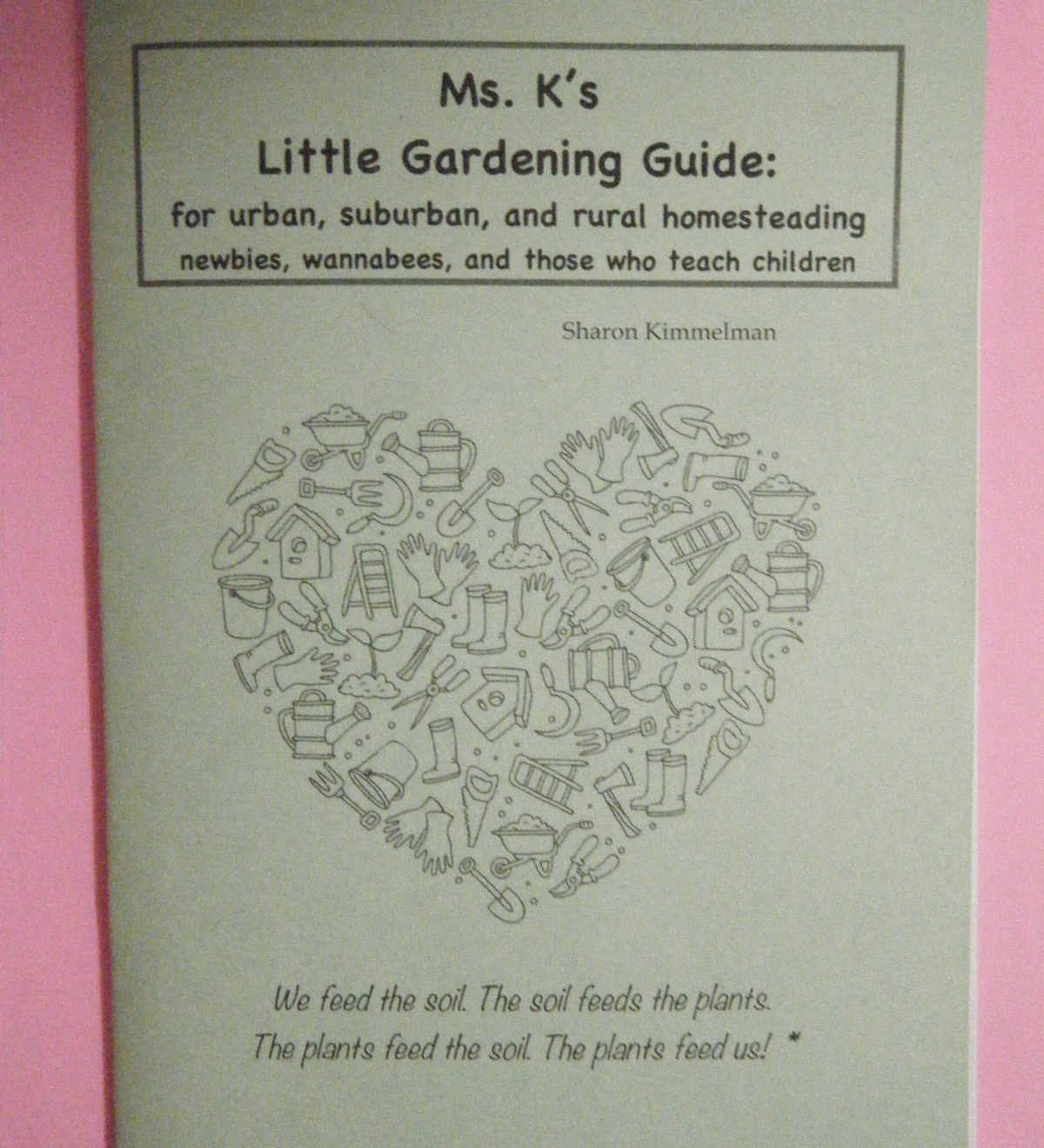Ms. K. Gives Vital Health Presentation on Gardening
Hungry Again? Learn to Garden for Life.
by Sharon Kimmelman (Ms. K.), Apr 2023
Do you remember as a child, wanting to flee school and go play? Daydreaming out the window, trying to bi-locate? I do! And as a teacher, I wanted to do that just as much, if not more. I still try to maximize my outdoor time. It took a long while to figure out how to both work and play outside, at the same time. I have been teaching food gardening to young children (and adults) over a 25 year span. As the need presented itself I added more grades. In 2012, I added a nutrition and food prep component.
I start the year (grade K – 5) with 3 question:
Who ate yesterday? Who ate today? Who wants to eat tomorrow?
“GOOD, let’s get started learning how to plant a food garden.”
It is habit but not prudent to assume that someone will feed you for the rest of your life, even though that’s the way city life has seemed. We don’t have to become farmers to learn enough of the basics to grow some edible green leafy plants and herbs and successfully harvest some. Lettuce, beet greens, radish tops, kale, and parsley are a few of many options. Of course, you want to plant what you like, but like the preppers say, if you have some space, plant a little of what others like, so you can trade. If you have been thinking of taking this on, K.I.S.S. Keep It Simple, Simon.
THE FACTS, MA’AM. JUST THE FACTS.
If you can put together the basics, you’re way ahead of the game. If you have most of it, it’s likely you can supplement or improvise the rest as you go. It’s nice to garden with a buddy. Lots of people are taking up growing some food. Your skills and experience are likely to be somewhat complementary. The quality of food (nutrient density) is more of a concern on a grand scale. The control you will have over a small area will allow you to achieve high standards; the freshness factor will drive you over the top.
Knowing how food plants grow is an essential skill. Take it on as a necessity, a hobby, a curiosity, a conversation starter. No need to concern yourself with growing all of your own food; start with just a bit, a favorite herb, a rare edible variety; that might be all you need or want.
WHAT IS NEEDED TO START?
BASIC PLANT NEEDS (generally)
- container with drainage holes and a tray under it
- soil
- water
- seeds or young plants
- light- about 3 hours for greens; fruiting plants need 6+ hrs., (add lights if needed)
- moderate temps, >55ºF
- space, air, ventilation- plants eat from the air even more than from their roots.
- soil nutrients, a bit periodically
- stakes (sticks) to support upright stems and vines, use singly or tie into a trellis,
- jute, string or tee shirt strips for tying
LOCATION- A flat surface with some natural light, if possible- a window sill, tea table, patio, balcony, skylight, a neighbor’s space, a secret place in the park with water reasonably nearby or carried in. Start simple.
CONTAINERS- About 6” deep and 4” across will hold a chard plant, lettuce or scallions, chives, other greens. Look at what the growing plant looks like, if you have only seen rubber banded leaves from the market. An 8” diameter pot can hold a mini compact tomato or pepper, edible flowers, more greens. Consider a window box, clay terra cotta pots, plastic pots, milk cartons, something recycled. Tiny clay pots dry out quickly. Plastic pots hold water better.
SOIL- A plain quality blend, no time-release fertilizer. The added ingredient of compost on the label means there will be nutrition available for when the seedlings start to feed.
WATERING- Gentle and thorough is the way to go. If you have several pots, water them lightly and go back for another pass (and maybe a 3rd) until you see water pool in the saucer or tray. This gives the soil a chance to take up and hold the water for the roots. It is likely to absorb whatever pooled in an hour or two. If it’s there 6 hours later, drain it. Every home environment has got a unique combination of factors so, put your pinky in the soil and check if it is still wet 2 inches down.
LIGHT- Many seeds in soil benefit from bottom heat. But not essential. Indoor temps will suffice. But as soon as they’re up, they’ll need light. Try a couple of lamps or fluorescent tubes right above the seed flats. Toughen up the stems by brushing a hand across the tops gently. It replaces natural air currents. If you set up a fan nearby, you are likely to have to water a little more. Evaporation, you know. You’ll know if the light isn’t strong or long enough if your plants get ‘leggy’ (spindly stems).
SEEDS- The seed packet info is very useful. It contains:
- seed producer
- plant type
- plant variety
- standard OR hybrid seed*
- height and habit (upright, vine, creeper, compact)
- how/when to sow indoors
- time to direct seed or transplant outdoors (some have a zone map)
- final spacing between plants**
- days to maturity/harvest
*If the seed is a standard variety, the seed you save at the end of the season will grow true to its parents’ characteristics; if the seed is hybrid (crossed) seed (F1 generation), is saved, it will be F2 generation and will contain the less desirable characteristics of the grandparent plants)
*Tip: you can sow seeds much closer and then pick out and eat the baby plants as they grow until you reach the final spacing, then leave the remaining ones to mature. You can re-seed in the space around the maturing plants, as long as you feed a little and harvest then while young.
WHAT DO SOWN SEEDS NEED TO GERMINATE- Most benefit from bottom heat for earlier germination. That is why starting seed indoors is a good strategy. Sowing in cold soil too early outdoors can result in rotted seed, low germination, or sprouted seed that is killed by low air temps. Also, seeds have a life span of a few or several years, which differ by type.
TECHNIQUES FOR BEGINNING IN A SMALL PLOT- Sow one type of seed or buy your transplants. If you have room, Intercrop meaning plant 2 or 3 type of seed in an area. This works when they are fast and slow maturing growing together. Take note that:
- the growing season by zone (see a map), is only part of what you consider about temps (microclimates, rainfall, microclimate pockets, etc.)
- area can have 3 or 4 distinct seasons in the growing season
- crops sometimes do better in a certain part of the overall season
- gardens can be designed to extend the growing time with ‘cut and come again’ types and protection from the elements.
Plants will grow in ground, on ground, above ground. Consider the habit of its growth when choosing.
KITCHEN SPROUTING- Another type of gardening is sprouting seed to eat or sowing them for microgreens.
Seeds for sprouting are sold by the pound. You need a jar or a net bag and water. Stackable sprout trays are available, too. It takes 3 – 5 days depending on the type of seed. Sprouts are perishable. Soak what you can eat in a few days. After they have reached the stage you like, store them in the fridge. Typically, sunflower sprouts and microgreens are sown in shallow trays of soil and harvested with a scissors. Some types will regrow for another harvest or more as long as there is enough soil nutrition.
I enthusiastically encourage people, if at all possible, to try out some edible plants this season. Start anytime. Even if it’s just a pot of chives, other herb, or lettuce with a few radishes growing around it. Dig in and get growing!
If you could use some help or guidance with your garden projects, consider my merch:
– “Ms. K’s Little Gardening Guide”, in print or e-book.
– “City Seedlings” is her seasonal side hustle, 200 seedlings of varieties of greens, tomatoes, peppers, a few flowers and herbs; this year, rooted fig and elderberry starts, & raspberry canes. Sample seed packets, too.
– including Brixie’s Compost Tea Bag to make a small quantity of your own liquid fertilizer whenever you need it,
– a few of my favorite upcycled tools to help newbies dig in and get growing.
– instructions on making sprouts, Kombucha, and water kefir for your kitchen escapades
– a consultation to help set up your garden space, no matter how small.
– a private or small group class to learn and do the basics.
– I’m going to try my hand at posting some beginner videos on YT. Stay Tuned.
Find these and more on www.etsy.com/shop/MsKsGeneralStore and also on www.newyork.craigslist, search for City Seedlings or email me directly at sharki7007@yahoo.com







